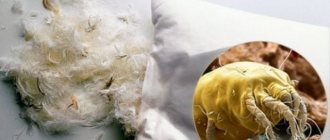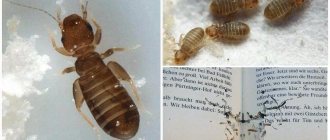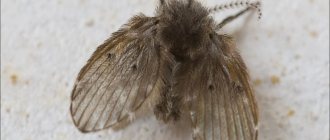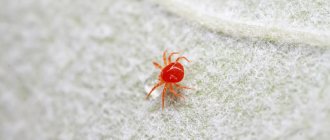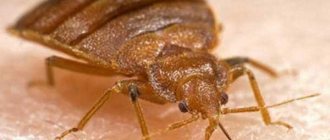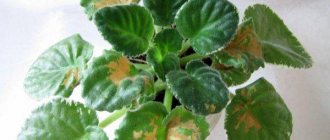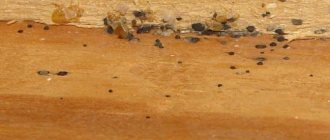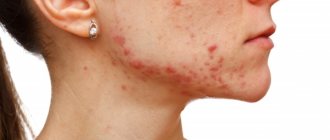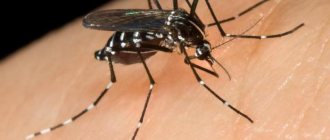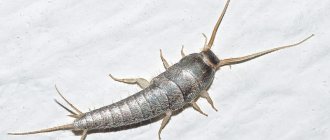A person does not think about being close to microscopic mites until an allergic reaction occurs. These synanthropic organisms have long settled in our homes. Here they found favorable conditions and food in the form of particles of human epidermis. Mites in pillows, blankets, and upholstered furniture are not visible to the naked eye, but for sensitive people their presence results in a bouquet of various diseases from dermatitis to bronchial asthma.
Microscopic inhabitants of pillows
Mites that live in feather pillows are not related to the parasites that live on birds. This is a separate species - Dermatophagoides or house dust mites. Their sizes are 0.1-0.3 mm, so we don’t even notice the presence of millions of arthropod creatures. When viewed through a microscope, an oval, convex body covered with bristles and four pairs of legs are visible. There are suction cups on the limbs with which the tick clings to the surface. At high magnification, you can see powerful chelicerae - claw-like appendages with which dust mites gnaw particles of skin.
Attention. According to scientists, colonies of arachnids make up about 80% of the dust in an apartment.
Dust mites belong to the class of arachnids, the order of acarimorphic mites. The peculiarity of this group is the ability to feed on hair, feathers, skin secretions and particles. 150 species of mites have been found in house dust. Dermatophagoides pferohysimmus and Dermatophagoides pteronyssinys play a major role in the formation of an allergic reaction in humans.
A large number of mites live not just in dust, but in bedding. There are several reasons for this choice:
- During sleep, we heat the pillow and bed to a comfortable temperature of +25-300, which is preferred by arachnids.
- Skin secretions cause increased humidity.
- A large amount of human epidermis remains in the bed, on which ticks feed.
Information. Arthropods that live in dust and bedding do not bite humans or suck their blood. They are not carriers of dangerous diseases like the Ixodid species.
How do ticks get into the house? They can be carried on clothing, when pillow filling is not properly treated, or on pet fur. The lifespan of parasites is 65-80 days. During this time, the female manages to lay 60-200 eggs. Arthropods spend most of their lives feeding on human remains. They defecate up to 20 times per day. Excrement is the main cause of allergic reactions in humans. If you consider that millions of individuals live in bed, then it is clear what kind of load is placed on the immune system.
Attention. Without washing, a feather pillow over a period of 5 years consists of 50% of its weight from dust, skin secretions, mites and their waste products.
Description of the parasite, causes of appearance
Ticks belong to the family of small arachnids.
They are divided into two orders: acariformes and parasitiforms. Acariform mites are closer to phalangeal arachnids, while parasitiform mites belong to the class of harvesters. The feather mite (photo presented in the article) belongs to the order Acariformes. The parasite is almost impossible to detect; it has a transparent scaly body, and its dimensions do not exceed 0.5 mm in length. Due to the peculiarities of its structure, it cannot bite a person, however, the protein that it secretes in the process of life can cause an acute allergic reaction.
The main reasons for the appearance of the insect are unsanitary conditions and careless attitude towards personal and bedding. Ticks spread very quickly. It is impossible to completely get rid of them, but you can significantly reduce their numbers.
Habitat
The pests live and breed on birds' feathers, causing them to fall out over time. In residential buildings, feather mites are most often found in pillows (photo below), upholstered furniture, carpeting and places where dust accumulates. However, down and feather pillows are considered the most favorable habitat for the parasite.
Feather base and human sweat combine to create the optimal temperature and humidity necessary for insect reproduction. Most people ventilate the room before going to bed, thereby improving the living conditions of the insect, since fresh air is one of the main components of its life support.
If not properly cared for, any down or feather product will gain weight after a few years due to the accumulation of dust and mites. On average, there are up to 200 individuals for every centimeter of feather pillow. As a rule, parasites get onto human skin from down or feather products, causing clearly noticeable discomfort.
Since it is extremely difficult to completely get rid of feather mites, down and feather filling of bedding is prohibited in most developed countries. This mainly concerns municipal children's institutions, hospitals, sanatoriums, hotels, barracks and student dormitories.
Modern manufacturers give preference to synthetic fillers such as padding polyester and holofiber. It is much easier to care for such products; in addition, the existence of parasites in them is almost impossible. For people who prefer natural materials, bedding with bamboo or coconut fiber, buckwheat, pine needles and even purified meadow hay is recommended. It is advisable to update pillows once a year.
Danger to humans
If treatment is not started in time, feather mites can cause acute allergic reactions or aggravate existing diseases:
- Asthma. The patient experiences attacks of the disease more often.
- Allergies are possible with a severe cough, watery eyes and runny nose. If you eliminate the allergen, you feel better and the symptoms disappear.
- Hives are accompanied by itching, and characteristic pink spots appear on the body.
- Atopic dermatitis - manifested by redness and peeling of some areas of the skin, severe itching is possible. The disease requires long-term treatment.
- Swelling of the airways is the most dangerous possible reaction, as it can be fatal.
Danger of House Dust Mites
Small particles of Dermatophagoides mites and their feces are strong allergens. The excrement contains the proteins Der f1 and Der p1. They have a particularly detrimental effect on children living in urban areas. In rural areas, where a child comes into contact with animals and various microorganisms, he develops a strong immune system. Urban children are more susceptible to diseases; in 70% of cases of bronchial asthma, the source of the problem was an allergy to dust mites. Particles and secretions of arachnids enter the human body through the respiratory tract. Contact with them causes immune reactions on the skin. In areas of irritation, arthropod protein easily penetrates the skin, aggravating the problem.
Symptoms of an allergy to mites in pillows:
- sneezing and a feeling of nasal congestion without a cold;
- obsessive, incessant cough;
- loss of appetite;
- shortness of breath and difficulty breathing during exercise;
- swelling of the eyelids, itching;
- red rashes on the face.
When performing diagnostics, the presence of an allergen to house dust mites is detected. In addition to an allergic reaction, they cause other serious illnesses:
- conjunctivitis;
- atopic dermatitis;
- bronchial asthma;
- allergic rhinitis.
Information. In many countries, feather and down filled pillows are prohibited for use in hotels, childcare centers and hospitals.
Harm to humans
It is not the feather mites themselves that pose a danger to human health, but their metabolic products. Insect feces contain special food enzymes Der p1 and Der f1, which break down particles of the epidermis and hair. It is these proteins that are the strongest allergens.
Conjunctivitis
Therefore, feather mites in humans cause:
- bronchial asthma;
- atopic dermatitis;
- rhinitis;
- conjunctivitis
However, any treatment will only bring temporary relief. Until the allergen is eliminated from the apartment, health problems cannot be avoided.
How to get rid of ticks in the house
There are several ways to get rid of ticks in pillows. It is worth considering that the effect of the majority is temporary. Maintaining cleanliness and caring for bedding are the basic rules that help reduce the number of synanthropic parasites.
Impact of temperature
Parasites have always lived in feather pillows, and low temperatures have traditionally been used to combat them. On a cold winter day, it is recommended to take the pillows outside and leave them for several hours. The longer they stay in the cold, the better. More ticks will die during this time.
In summer, bedding is placed in direct sunlight. This is both heating and exposure to ultraviolet radiation. The internal filling dries well, and parasites do not like dryness. Exposure to UV rays neutralizes tick waste products. Another opportunity to influence uninvited residents is treatment with a steam cleaner. The disadvantage of this method is that it only affects adults. Eggs are not sensitive to cold and heat. This means that after some time a new generation of dust mites will grow up.
Information. To treat bedding in hospitals and hotels, special chambers are used, where not only adult ticks are destroyed, but also their eggs.
Treatment
Feather mites cause harm to the entire body; in order to be completely cured, a set of actions is required. These include the fight against the number and reproduction of individuals, as well as drug treatment of skin diseases.
First of all, you need to contact a specialist to establish a diagnosis and take tests; only in this case can the doctor prescribe individually suitable therapy.
Typically this is:
- course intake of vitamins and minerals;
- anti-inflammatory ointments;
- soap that gets rid of ticks on the skin;
- in rare cases, the doctor may prescribe antibiotic treatment.
On average, it takes from 1.5 to 2 weeks to eliminate external manifestations of a tick infestation.
Acaricidal preparations for use in the home
Regular washing of bedding and ironing helps to effectively cope with parasites. But not all fabrics can be washed at high temperatures and ironed. To neutralize allergens and cope with mites at any temperature, a special Acaril liquid is added to the washing machine. The same product, released in powder form, can be used to clean carpets.
Wet cleaning is the main weapon in the fight against dust and its inhabitants. Its effect can be enhanced by adding special All-Rug shampoo to the water. The product is sold as a concentrate and can be used to clean natural and synthetic pile of furniture and carpets. It is used in a washing vacuum cleaner and for manual cleaning. The drug is diluted 1:30 in the first month, then a solution of 1:60 is sufficient. The product removes dirt, allergens and mold well, and has a pleasant aroma.
The Allergoff line of products is an acaricidal additive for washing bed linen and a spray. One sachet of Allergoff rids laundry of mites and their waste products. It also works against fleas and can be used to wash pet bedding.
Allergoff spray is capable of destroying parasites at any stage of development. The aerosol form makes it easy to treat mattresses, blankets, carpets and upholstered furniture. The action of the acaricidal drug causes the death of mites in down pillows 1 hour after spraying. Bedding must be treated from all sides. The product is safe for people; objects can be used 1 hour after its application. The active components of the drug are placed in special capsules, their effectiveness is 6 months. The spray is odorless and does not leave stains after use.
Spray "Akarosan" when sprayed, penetrates into the body of dust mites when feeding and through the chitinous shell. The main active ingredient of the drug is benzyl benzoate. The spray enlarges arthropod excrement, allowing it to be collected with a vacuum cleaner. Particles of the drug remain in the structure of the treated surface for a long time. They have a detrimental effect on subsequent generations of ticks. The protective effect of Akarosan is 6-9 months.
Folk recipe
Table salt will help reduce the number of parasites. It is necessary to prepare a solution from it: 200 g of the product is dissolved in 1 liter of warm water. This composition wipes the areas of greatest accumulation of dust mites - baseboards, window sills, shelves. After moistening a napkin in this solution, wipe upholstered furniture, toys, and mattresses. The main advantages of the solution are affordable cost and effectiveness. The apartment is treated 2-3 times a month.
Habitat
Dust mites (a photo under a microscope makes it possible to study a parasite that looks like a small spider) prefer to settle in places with a large accumulation of dust: on bookshelves, in carpets, under baseboards.
The parasite also pays attention to the upholstery of home furniture, feather or down pillows and woolen blankets. Apartments or houses with high humidity (at least 55 - 60%) and musty air are ideal for the life and reproduction of insects. The room temperature should vary between 19 and 25° C.
Caring for feather pillows
You don't have to give up your favorite feather pillows because of mites. They need to be looked after properly. In addition to seasonal drying and freezing, feather washing is recommended. Once every 2 years, pillows are taken to dry cleaning, where appropriate treatment is carried out. You can wash your feathers at home. To do this, you will need a canvas bag the size of a pillow, soap, and ammonia.
The work is performed in the following sequence:
- The feather is poured into a prepared bag, which is tied tightly.
- A special soap solution is prepared in a basin or other container with a volume of 10 liters. You will need 100 g of laundry soap and 100 g of ammonia. After mixing all the ingredients, a bag of feathers is lowered into the container.
- Soaking takes place for 4 hours, periodically the bag is turned over, and the contents are kneaded with your hands.
- Next is rinsing, you will need to change the water several times until all the soap and dirt disappears.
- Fabric with wet feathers is hung in a draft. Washing is done on a sunny day so that everything dries quickly. You will need to wait until it dries completely. In order for the pen to dry evenly, you need to periodically shake it and knead it.
At the same time, the diaper is washed with the addition of an acaricidal drug. Dry fabric is ironed.
ethnoscience
Many people prefer to turn to alternative medicine methods to treat feather mite bites.
- One of the most effective recipes for parasitic effects is calendula infusion. The product is applied to a cotton pad and treated for skin inflammation.
- You can use aloe juice as a compress: apply to a bandage and apply to the skin.
- In case of severe damage to the skin, mix castor oil with trichopolum and apply a bandage for 8-10 hours daily.
Replacement of down and feather
The times when down pillows were considered the best are in the past. Today there are many fillers in which parasites do not like to settle.
Herbal options include:
- buckwheat husk – elastic, hypoallergenic, with a pleasant aroma;
- bamboo fiber – antibacterial, elastic, breathable;
- latex is elastic, easy to clean, eliminates the appearance of mites and other microorganisms.
Synthetic polyester fillers allow for more frequent hygienic treatment:
- holofiber – non-woven material;
- comfort - elastic polyester balls;
- Sintepon is an inexpensive material, but quickly loses its shape.
When choosing a filler, consider the age and individual needs of the person. For children, it is better to choose natural fibers that do not cause allergies. Ticks that live in pillows do not grow in buckwheat and bamboo.
Conclusion
A feather pillow is an environmentally friendly product, so to speak. It has a number of worthy qualities, thanks to which the product served our ancestors for many years. Now scientists are attributing more and more shortcomings to it, proposing to replace natural feathers with a synthetic analogue. However, the point is omitted that synthetic fillers also have a number of positive and negative characteristics.
By choosing a high-quality feather pillow, the buyer receives a natural product that, with proper care, will last a long time.
Sources
- https://FB.ru/article/411724/perevoy-klesch-lechenie-i-simptomyi-u-cheloveka
- https://StopKlopam.com/kleshhi-v-podushkah/
- https://misterklop.ru/klesshi/kleshhi-v-podushkah-perevye-kleshhi-prichina-bessonnitsy-kto-takie-otkuda-berutsya-opasny-li-dlya-cheloveka-i-kak-ot-nih-izbavitsya- foto-pod-mikroskopom
- https://like2sleep.com/postelnye-prinadlezhnosti/podushki/kleshhi-v-podushkakh-kak-izbavitsya-ot-nep.html
- https://dezvredexpert.com/kleshhi/vidy-kleshhej/kleshhi-v-podushkax/
- https://sichovka.ru/parazity/kleshchi-v-podushkah.html
- https://DobryjSon.ru/spalnoe-mesto/uhod/kleshhi-v-podushkax.html
- https://beetlestop.ru/kleshi-v-podushkah/
- https://polzaivredno.ru/perevye-podushki-chem-vredny-i-chem-polezny/
[collapse]
Preventive actions
To protect your loved ones from allergic reactions and reduce the negative impact of dust mites to a minimum, following simple rules:
- Change pillows and mattresses every 5-6 years. Without proper care, they accumulate a huge amount of mites and mold.
- All bedding, as well as bedspreads, pajamas, and dressing gowns should be washed and shaken out as often as possible. It is recommended to dry these items in the sun.
- Use acaricidal sprays to treat the surface of upholstered furniture, toys, and carpets.
- Regularly carry out wet cleaning of the premises, do not allow dust to accumulate under the bed and in the corners of the room.
- If one of the family members is prone to allergies, it is necessary to remove items from the house that accumulate dust - carpets, drapes.
- Ventilate rooms frequently and maintain humidity at 40%.
- Refuse to store old pillows and mattresses in your apartment and immediately get rid of unnecessary things.
It is impossible to completely destroy dust mites; their population is regularly replenished. But everyone can reduce their numbers and make their home safe.
What should not be done if an infection is detected?
A person who has discovered a feather mite infestation should absolutely not:
- squeeze pimples with your own hands, this way you can introduce infection into the deep layers of the skin and blood;
- use decorative cosmetics - mite larvae may remain on it, which in the future will lead to re-infection;
- use creams, since the parasite’s habitat improves and the infection spreads throughout the face;
- carry out cosmetic procedures such as scrub, massage, cleansing and masks;
- visit the swimming pool, sauna, solarium;
- wash with hot water.
In addition, it is highly recommended to review your daily diet. Avoid processed foods, canned, smoked, spicy and fried foods. Add less salt and spices to food. Avoid alcohol during treatment. You can eat chocolate and drink coffee in reasonable quantities.
Features of cleaning.
: 1.5-2 minutes for every 0.5 m2 of surface, especially various decorative stitches, folds and buttons, which can serve as shelters for ticks.
